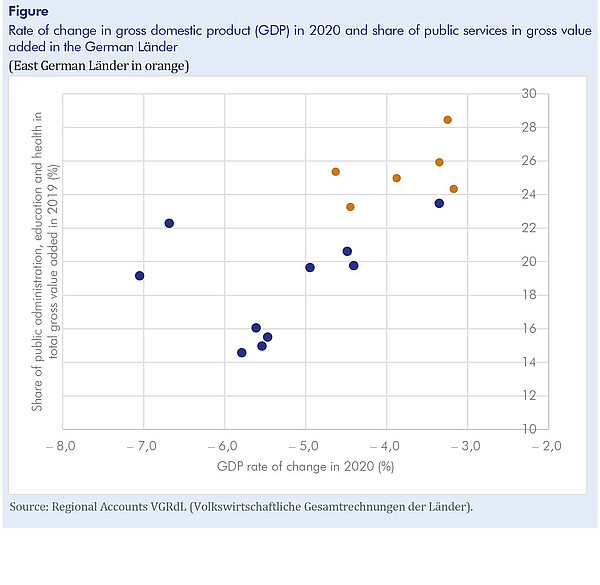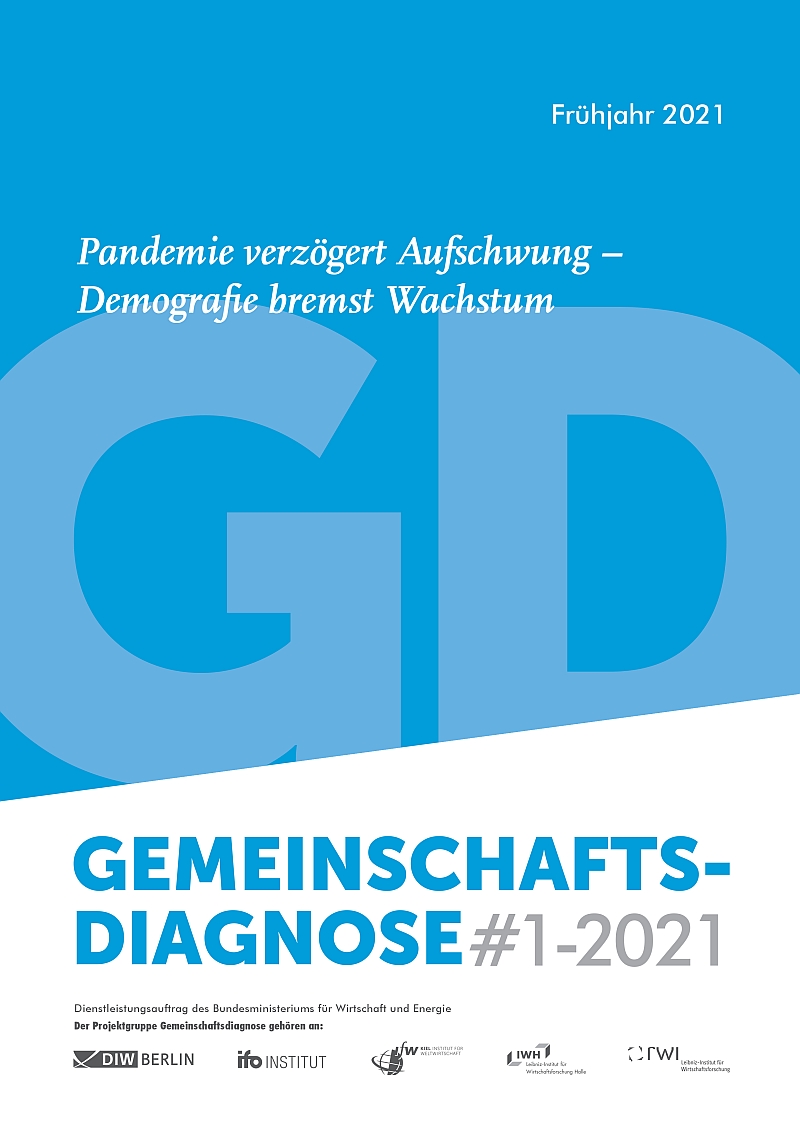Economy in East Germany shrank less than in the West, but will have weaker momentum when pandemic disappears – Implications of the Joint Economic Forecast Spring 2021 and new data for East Germany
In its Spring Report, the Joint Economic Forecast Project Group states that the ongoing pandemic will delay the upswing in Germany until well into the summer. This also applies to East Germany, even more so as at present (mid-April) Thuringia, Saxony and Saxony-Anhalt are the states with the highest incidences nationwide. Until last autumn, the pandemic was not widespread in East Germany. That is one reason why production here in 2020 shrank less (by 3.8%) than in Germany as a whole (–4.9%). Oliver Holtemöller, Head of the Department Macroeconomics and Vice President at the Halle Institute for Economic Research (IWH) says that also the special economic structure contributed to this: In East Germany, two economic sectors that expanded last year have a greater weight than at the national level; these are the construction sector and in particular the sector "public administration, education and health" (see figure).
If the rates of change in the main economic sectors in 2020 for Germany are weighted with the shares of total production applicable to East Germany, the result is therefore a decline in total gross value added that is about half a percentage point below the actual decline. In addition, the hard-hit automotive industry plays a smaller role in the East than in West Germany. Furthermore, private incomes are likely to have developed more favourably. While gross wages and salaries fell by 1.1% in West Germany, they increased by 1% in the East. One reason for this is that the volume of work had to be cut back less. Moreover, while wages are still lower in East Germany, they trend to grow a bit faster than in the West. Finally, the pension adjustment is 0.7 percentage points higher each year than in the West until the East's pension value will be fully aligned with that of the West.

Since production shrank less in East Germany, it is unlikely to expand as strongly as in the West when the shutdowns will gradually be lifted later this year. Moreover, most of the firms that are currently benefiting from the strong global demand for industrial goods are situated in the West. At 3%, growth in East Germany is expected to be lower in 2021 than in Germany as a whole (3.7%). A growth rate of 3% is forecasted for 2022 as well. The unemployment rate in East Germany as defined by the Federal Employment Agency falls from 7.3% in 2020 to 7.1% in 2021, and is expected to be 6.5% in 2022.
Joint Economic Forecast, spring 2021 report (in German):
Joint Economic Forecast: Pandemie verzögert Aufschwung – Demografie bremst Wachstum. April 2021. Essen 2021.
Whom to contact
For Researchers

Vice President Department Head
If you have any further questions please contact me.
+49 345 7753-800 Request per E-MailFor Journalists

Internal and External Communications
If you have any further questions please contact me.
+49 345 7753-832 Request per E-MailIWH list of experts
The IWH list of experts provides an overview of IWH research topics and the researchers and scientists in these areas. The relevant experts for the topics listed there can be reached for questions as usual through the IWH Press Office.
Related Publications

Pandemie verzögert Aufschwung – Demografie bremst Wachstum
in: Dienstleistungsauftrag des Bundesministeriums für Wirtschaft und Energie, 1, 2021
Abstract
Das erste Jahr der Corona-Pandemie stand in Deutschland im Zeichen extremer Schwankungen der ökonomischen Aktivität und einer massiven Lähmung der Binnenwirtschaft. Der kräftige Erholungsprozess nach dem Ende des Shutdowns im vergangenen Frühjahr kam im Zuge der zweiten Infektionswelle über das zurückliegende Winterhalbjahr insgesamt zum Erliegen, wobei es große Unterschiede zwischen Industrie und Dienstleistern gibt. Angesichts des aktuellen Infektionsgeschehens gehen die Institute davon aus, dass der derzeitige Shutdown zunächst fortgesetzt wird und die zuletzt erfolgten Lockerungen wieder weitgehend zurückgenommen werden. Erst ab Mitte des zweiten Quartals setzen Lockerungsschritte ein, die es den im Shutdown befindlichen Unternehmen erlauben, ihre Aktivitäten nach und nach wieder aufzunehmen. Bis zum Ende des dritten Quartals sollten dann alle Beschränkungen aufgehoben worden sein, weil bis dahin insbesondere mit einem weitreichenden Impffortschritt zu rechnen ist. Insgesamt dürfte das Bruttoinlandsprodukt in diesem Jahr um 3,7% zulegen. Die deutliche Erholung im zweiten Halbjahr 2021 wirkt sich auch erheblich auf die Jahresdurchschnittsrate für das Jahr 2022 aus, die nach vorliegender Prognose 3,9% beträgt.



